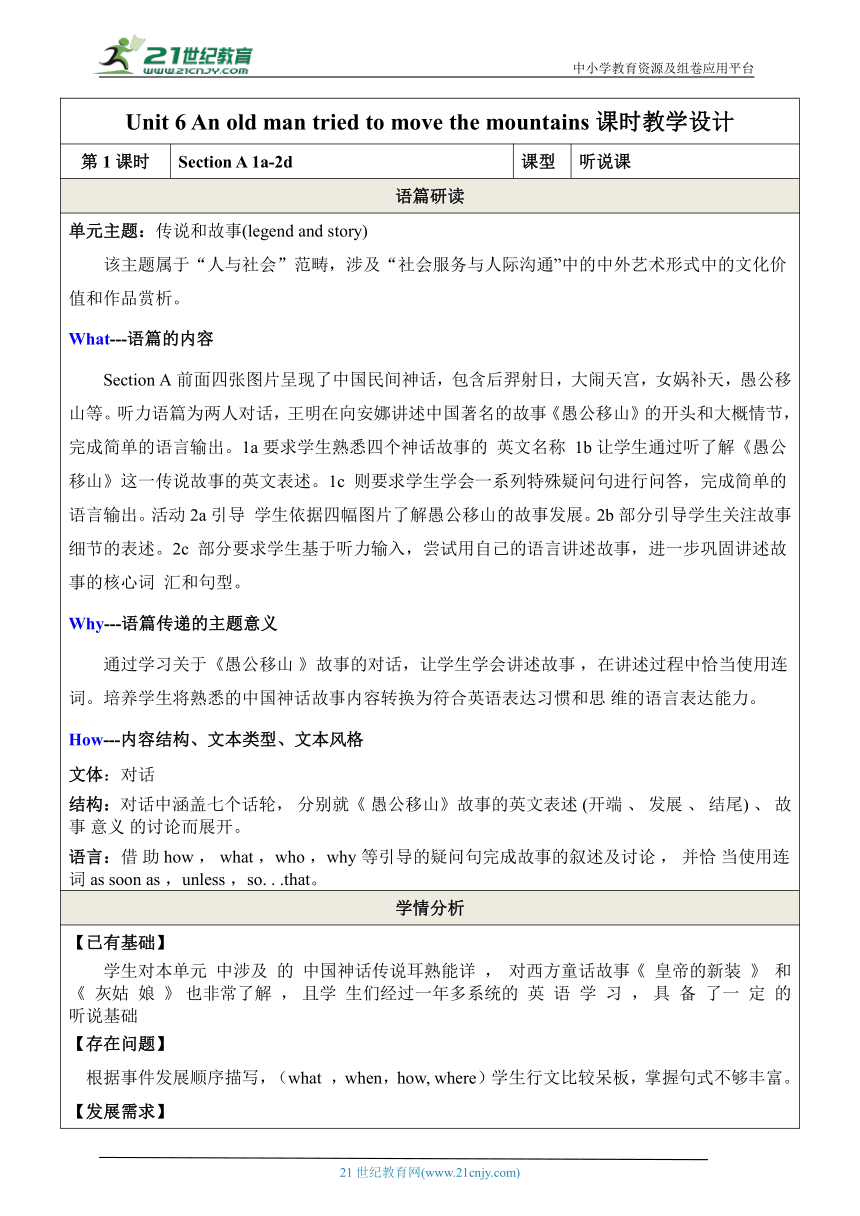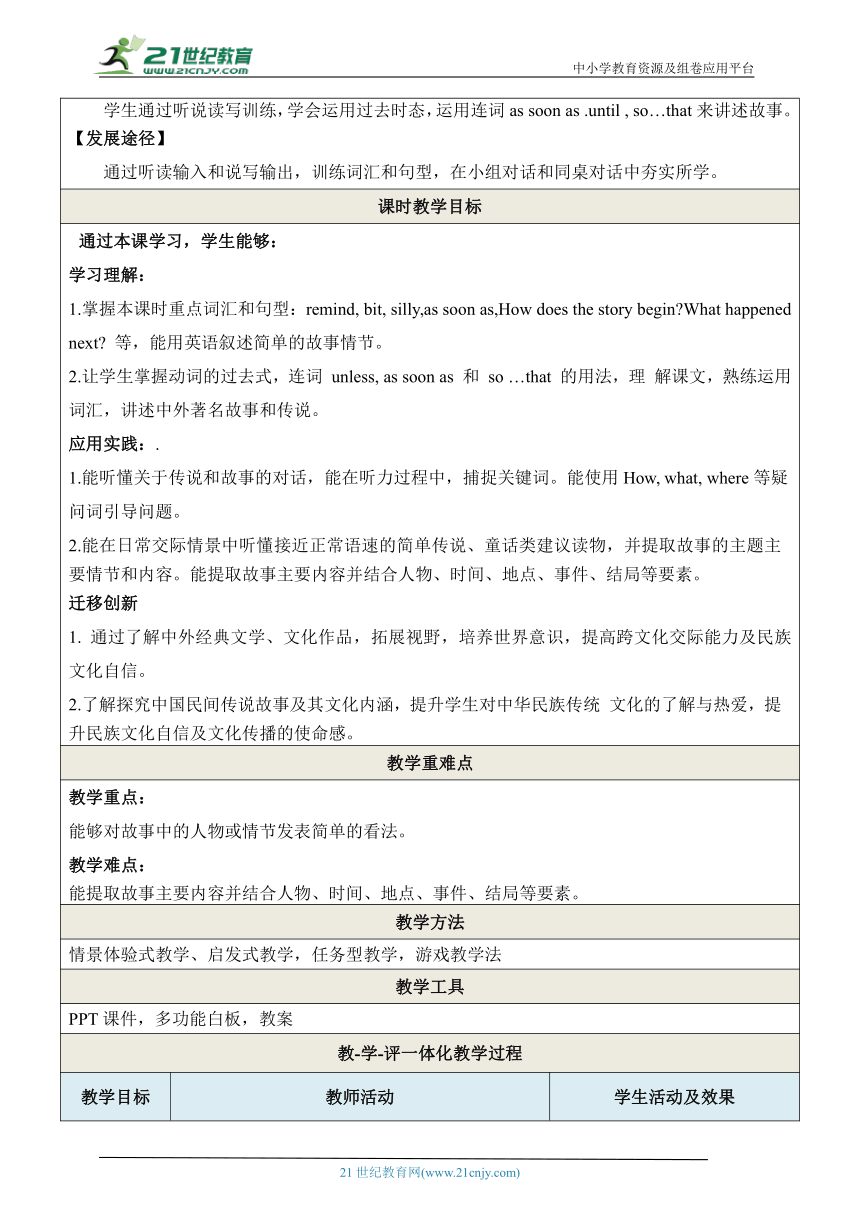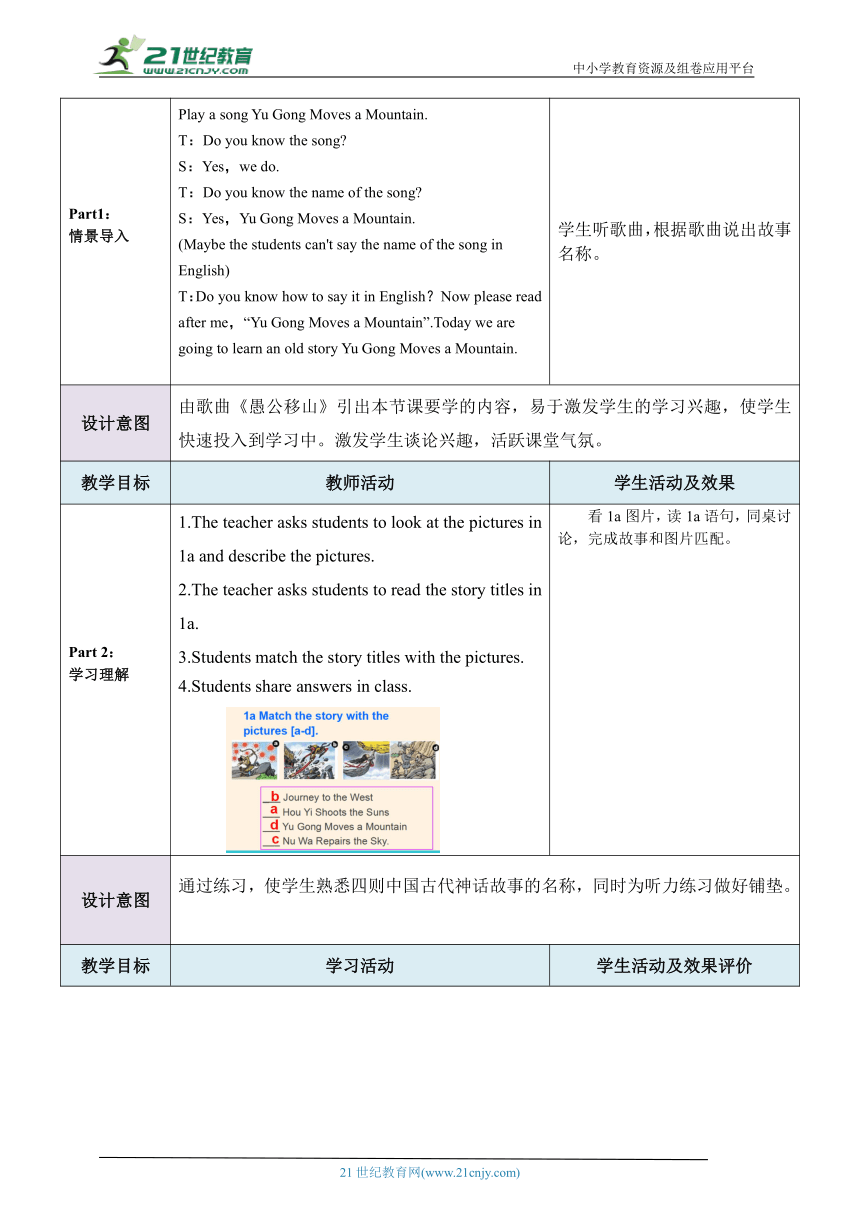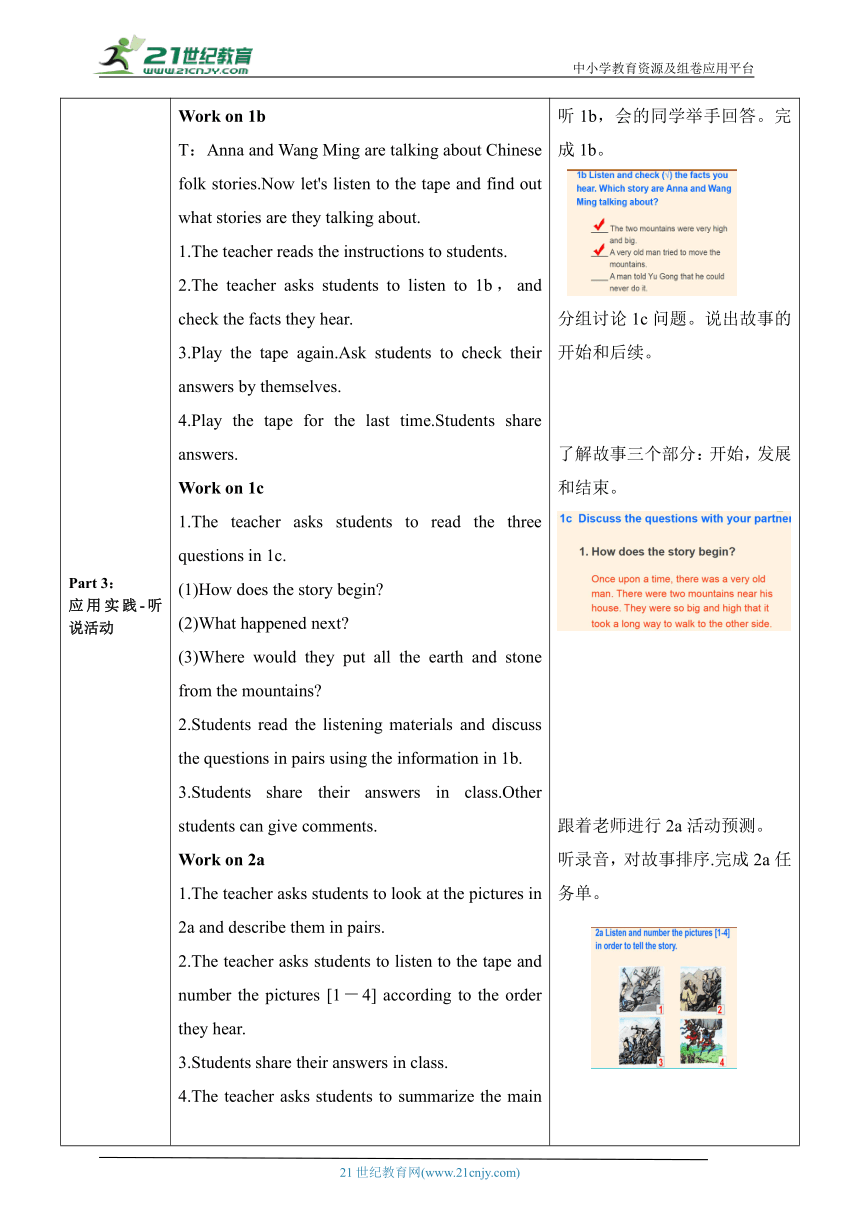Unit 6 An old man tried to move the mountains.第1课时 Section A 1a-2d 教学设计(人教版八年级下)
文档属性
| 名称 | Unit 6 An old man tried to move the mountains.第1课时 Section A 1a-2d 教学设计(人教版八年级下) |

|
|
| 格式 | docx | ||
| 文件大小 | 1.3MB | ||
| 资源类型 | 试卷 | ||
| 版本资源 | 人教新目标(Go for it)版 | ||
| 科目 | 英语 | ||
| 更新时间 | 2024-04-26 10:26:53 | ||
图片预览




文档简介
中小学教育资源及组卷应用平台
Unit 6 An old man tried to move the mountains课时教学设计
第1课时 Section A 1a-2d 课型 听说课
语篇研读
单元主题:传说和故事(legend and story) 该主题属于“人与社会”范畴,涉及“社会服务与人际沟通”中的中外艺术形式中的文化价值和作品赏析。 What---语篇的内容 Section A前面四张图片呈现了中国民间神话,包含后羿射日,大闹天宫,女娲补天,愚公移山等。听力语篇为两人对话,王明在向安娜讲述中国著名的故事《愚公移山》的开头和大概情节,完成简单的语言输出。1a要求学生熟悉四个神话故事的 英文名称 1b让学生通过听了解《愚公移山》这一传说故事的英文表述。1c 则要求学生学会一系列特殊疑问句进行问答,完成简单的语言输出。活动2a引导 学生依据四幅图片了解愚公移山的故事发展。2b部分引导学生关注故事细节的表述。2c 部分要求学生基于听力输入,尝试用自己的语言讲述故事,进一步巩固讲述故事的核心词 汇和句型。 Why---语篇传递的主题意义 通过学习关于《愚公移山 》故事的对话,让学生学会讲述故事 ,在讲述过程中恰当使用连词。培养学生将熟悉的中国神话故事内容转换为符合英语表达习惯和思 维的语言表达能力。 How---内容结构、文本类型、文本风格 文体:对话 结构:对话中涵盖七个话轮, 分别就《 愚公移山》故事的英文表述 (开端 、 发展 、 结尾) 、 故事 意义 的讨论而展开。 语言:借 助 how , what ,who ,why等引导的疑问句完成故事的叙述及讨论 , 并恰 当使用连词as soon as ,unless ,so. . .that。
学情分析
【已有基础】 学生对本单元 中涉及 的 中国神话传说耳熟能详 , 对西方童话故事《 皇帝的新装 》 和《 灰姑 娘 》 也非常了解 , 且学 生们经过一年多系统的 英 语 学 习 , 具 备 了一 定 的听说基础 【存在问题】 根据事件发展顺序描写,(what ,when,how, where)学生行文比较呆板,掌握句式不够丰富。 【发展需求】 学生通过听说读写训练,学会运用过去时态,运用连词as soon as .until , so…that来讲述故事。 【发展途径】 通过听读输入和说写输出,训练词汇和句型,在小组对话和同桌对话中夯实所学。
课时教学目标
通过本课学习,学生能够: 学习理解: 1.掌握本课时重点词汇和句型:remind, bit, silly,as soon as,How does the story begin What happened next 等,能用英语叙述简单的故事情节。 2.让学生掌握动词的过去式,连词 unless, as soon as 和 so …that 的用法,理 解课文,熟练运用词汇,讲述中外著名故事和传说。 应用实践:. 1.能听懂关于传说和故事的对话,能在听力过程中,捕捉关键词。能使用How, what, where等疑问词引导问题。 2.能在日常交际情景中听懂接近正常语速的简单传说、童话类建议读物,并提取故事的主题主要情节和内容。能提取故事主要内容并结合人物、时间、地点、事件、结局等要素。 迁移创新 1. 通过了解中外经典文学、文化作品,拓展视野,培养世界意识,提高跨文化交际能力及民族文化自信。 2.了解探究中国民间传说故事及其文化内涵,提升学生对中华民族传统 文化的了解与热爱,提升民族文化自信及文化传播的使命感。
教学重难点
教学重点: 能够对故事中的人物或情节发表简单的看法。 教学难点: 能提取故事主要内容并结合人物、时间、地点、事件、结局等要素。
教学方法
情景体验式教学、启发式教学,任务型教学,游戏教学法
教学工具
PPT课件,多功能白板,教案
教-学-评一体化教学过程
教学目标 教师活动 学生活动及效果
Part1: 情景导入 Play a song Yu Gong Moves a Mountain. T:Do you know the song S:Yes,we do. T:Do you know the name of the song S:Yes,Yu Gong Moves a Mountain. (Maybe the students can't say the name of the song in English) T:Do you know how to say it in English?Now please read after me,“Yu Gong Moves a Mountain”.Today we are going to learn an old story Yu Gong Moves a Mountain. 学生听歌曲,根据歌曲说出故事名称。
设计意图 由歌曲《愚公移山》引出本节课要学的内容,易于激发学生的学习兴趣,使学生快速投入到学习中。激发学生谈论兴趣,活跃课堂气氛。
教学目标 教师活动 学生活动及效果
Part 2: 学习理解 1.The teacher asks students to look at the pictures in 1a and describe the pictures. 2.The teacher asks students to read the story titles in 1a. 3.Students match the story titles with the pictures. 4.Students share answers in class. 看1a图片,读1a语句,同桌讨论,完成故事和图片匹配。
设计意图 通过练习,使学生熟悉四则中国古代神话故事的名称,同时为听力练习做好铺垫。
教学目标 学习活动 学生活动及效果评价
Part 3: 应用实践-听说活动 Work on 1b T:Anna and Wang Ming are talking about Chinese folk stories.Now let's listen to the tape and find out what stories are they talking about. 1.The teacher reads the instructions to students. 2.The teacher asks students to listen to 1b,and check the facts they hear. 3.Play the tape again.Ask students to check their answers by themselves. 4.Play the tape for the last time.Students share answers. Work on 1c 1.The teacher asks students to read the three questions in 1c. (1)How does the story begin (2)What happened next (3)Where would they put all the earth and stone from the mountains 2.Students read the listening materials and discuss the questions in pairs using the information in 1b. 3.Students share their answers in class.Other students can give comments. Work on 2a 1.The teacher asks students to look at the pictures in 2a and describe them in pairs. 2.The teacher asks students to listen to the tape and number the pictures [1-4] according to the order they hear. 3.Students share their answers in class. 4.The teacher asks students to summarize the main idea of the story. Work on 2b 1.The teacher asks students to read the sentences in 2b by themselves. 2.The teacher asks students to listen to the tape again and circle the words they hear. 3.Students share their answers in class. 4.The teacher asks students to retell the story according to 2b. 听1b,会的同学举手回答。完成1b。 分组讨论1c问题。说出故事的开始和后续。 了解故事三个部分:开始,发展和结束。 跟着老师进行2a活动预测。 听录音,对故事排序.完成2a任务单。 掌握2b句子意义。听录音,完成2b词汇选择。
设计意图 听前预测,听中获取关键信息。帮助学生有针对性地去听。掌握故事发展脉络。
Part 4: 迁移创新 1.T asks Ss to retell the conversation according to the mind map. Yu Gong Moves a Mountain Beginning:when who why Development:How what Ending: what 2.Discussion. T says,So what do you think about Yu Gong’s story 3.Go through 2d. T has Ss read the conversations in 2d and try to understand the meaning. 4.T explains some new words and main points in the conversation. 5.T may let some pairs to act out the conversation. 6.T lets Ss read the conversation and try to find their opinions. Then talk about with your Partner. 根据思维导图引导尝试用自己的话复述故事。 讨论对愚公移山故事的看法。 读2d对话,先尝试朗读2d对话内容。 熟知文章知识点。表演2d对话。根据2d对话完成表格。讨论你对愚公移山故事的看法?
设计意图 通过复述故事练习,进一步掌握本课时重要句型和语言的综合运用能力。 向愚公主动面对困难,坚持不懈努力的精神学习!
Step 5 Language Points Explain language points in this class. Ask Ss to finish the exercises on ppt. Get to the important language points . Finish the exercises on ppt.
设计意图 学会正确使用本堂课的目标语言。检测学生本堂课知识掌握情况,教师把握学情。
课时教学板书设计
Unit 6 Section A 1a-2d Key words:shoot,begin,god,remind,bit,silly Key phrases:once upon a time,instead of,work on,a little bit Key sentences:An old man tried to move the mountains.
评价量表
评价内容自评师评互评能听懂关于传说和故事的对话,能在听力过程中,捕捉关键词。能在日常交际情景中听懂接近正常语速的简单传说、童话。能提取故事主要内容并结合人物、时间、地点、事件、结局等要素
课时作业设计
作业内容 作业目标 设计意图
基础题: Remember what we learn today. 掌握本节课的基本单词和固定短语 能听懂关于传说和故事的对话
提高题: Write a story 练习用“How does the story begin 讲故事 能提取故事主要内容并结合人物、时间、地点、事件、结局等要素
课后反思(实施后填写)
本课采用学生熟悉的古老的神话故事图片引入话题,能让学生产生共鸣,产生一种想说的愿望,在学生轻松好奇的氛围中自然引人本节课的目标语言。听后活动的设计凸显层次性,特别是2c复述故事,有图片及提示语言,既巩固了本课所学的目标语言,又开拓了学生的思维,使学生的思维跳出了课本。但在听后活动“Interview”环节中,由于学生水平参差不齐,参与度不够广泛,在今后的教学过程中要多关注后进生和中间生,增强他们学习英语的兴趣和学好英语的信心。听力训练中的任务设计较为详细、全面,教师可根据实际情况合理地选择使用,特别是“Interview”环节。
21世纪教育网 www.21cnjy.com 精品试卷·第 2 页 (共 2 页)
21世纪教育网(www.21cnjy.com)
Unit 6 An old man tried to move the mountains课时教学设计
第1课时 Section A 1a-2d 课型 听说课
语篇研读
单元主题:传说和故事(legend and story) 该主题属于“人与社会”范畴,涉及“社会服务与人际沟通”中的中外艺术形式中的文化价值和作品赏析。 What---语篇的内容 Section A前面四张图片呈现了中国民间神话,包含后羿射日,大闹天宫,女娲补天,愚公移山等。听力语篇为两人对话,王明在向安娜讲述中国著名的故事《愚公移山》的开头和大概情节,完成简单的语言输出。1a要求学生熟悉四个神话故事的 英文名称 1b让学生通过听了解《愚公移山》这一传说故事的英文表述。1c 则要求学生学会一系列特殊疑问句进行问答,完成简单的语言输出。活动2a引导 学生依据四幅图片了解愚公移山的故事发展。2b部分引导学生关注故事细节的表述。2c 部分要求学生基于听力输入,尝试用自己的语言讲述故事,进一步巩固讲述故事的核心词 汇和句型。 Why---语篇传递的主题意义 通过学习关于《愚公移山 》故事的对话,让学生学会讲述故事 ,在讲述过程中恰当使用连词。培养学生将熟悉的中国神话故事内容转换为符合英语表达习惯和思 维的语言表达能力。 How---内容结构、文本类型、文本风格 文体:对话 结构:对话中涵盖七个话轮, 分别就《 愚公移山》故事的英文表述 (开端 、 发展 、 结尾) 、 故事 意义 的讨论而展开。 语言:借 助 how , what ,who ,why等引导的疑问句完成故事的叙述及讨论 , 并恰 当使用连词as soon as ,unless ,so. . .that。
学情分析
【已有基础】 学生对本单元 中涉及 的 中国神话传说耳熟能详 , 对西方童话故事《 皇帝的新装 》 和《 灰姑 娘 》 也非常了解 , 且学 生们经过一年多系统的 英 语 学 习 , 具 备 了一 定 的听说基础 【存在问题】 根据事件发展顺序描写,(what ,when,how, where)学生行文比较呆板,掌握句式不够丰富。 【发展需求】 学生通过听说读写训练,学会运用过去时态,运用连词as soon as .until , so…that来讲述故事。 【发展途径】 通过听读输入和说写输出,训练词汇和句型,在小组对话和同桌对话中夯实所学。
课时教学目标
通过本课学习,学生能够: 学习理解: 1.掌握本课时重点词汇和句型:remind, bit, silly,as soon as,How does the story begin What happened next 等,能用英语叙述简单的故事情节。 2.让学生掌握动词的过去式,连词 unless, as soon as 和 so …that 的用法,理 解课文,熟练运用词汇,讲述中外著名故事和传说。 应用实践:. 1.能听懂关于传说和故事的对话,能在听力过程中,捕捉关键词。能使用How, what, where等疑问词引导问题。 2.能在日常交际情景中听懂接近正常语速的简单传说、童话类建议读物,并提取故事的主题主要情节和内容。能提取故事主要内容并结合人物、时间、地点、事件、结局等要素。 迁移创新 1. 通过了解中外经典文学、文化作品,拓展视野,培养世界意识,提高跨文化交际能力及民族文化自信。 2.了解探究中国民间传说故事及其文化内涵,提升学生对中华民族传统 文化的了解与热爱,提升民族文化自信及文化传播的使命感。
教学重难点
教学重点: 能够对故事中的人物或情节发表简单的看法。 教学难点: 能提取故事主要内容并结合人物、时间、地点、事件、结局等要素。
教学方法
情景体验式教学、启发式教学,任务型教学,游戏教学法
教学工具
PPT课件,多功能白板,教案
教-学-评一体化教学过程
教学目标 教师活动 学生活动及效果
Part1: 情景导入 Play a song Yu Gong Moves a Mountain. T:Do you know the song S:Yes,we do. T:Do you know the name of the song S:Yes,Yu Gong Moves a Mountain. (Maybe the students can't say the name of the song in English) T:Do you know how to say it in English?Now please read after me,“Yu Gong Moves a Mountain”.Today we are going to learn an old story Yu Gong Moves a Mountain. 学生听歌曲,根据歌曲说出故事名称。
设计意图 由歌曲《愚公移山》引出本节课要学的内容,易于激发学生的学习兴趣,使学生快速投入到学习中。激发学生谈论兴趣,活跃课堂气氛。
教学目标 教师活动 学生活动及效果
Part 2: 学习理解 1.The teacher asks students to look at the pictures in 1a and describe the pictures. 2.The teacher asks students to read the story titles in 1a. 3.Students match the story titles with the pictures. 4.Students share answers in class. 看1a图片,读1a语句,同桌讨论,完成故事和图片匹配。
设计意图 通过练习,使学生熟悉四则中国古代神话故事的名称,同时为听力练习做好铺垫。
教学目标 学习活动 学生活动及效果评价
Part 3: 应用实践-听说活动 Work on 1b T:Anna and Wang Ming are talking about Chinese folk stories.Now let's listen to the tape and find out what stories are they talking about. 1.The teacher reads the instructions to students. 2.The teacher asks students to listen to 1b,and check the facts they hear. 3.Play the tape again.Ask students to check their answers by themselves. 4.Play the tape for the last time.Students share answers. Work on 1c 1.The teacher asks students to read the three questions in 1c. (1)How does the story begin (2)What happened next (3)Where would they put all the earth and stone from the mountains 2.Students read the listening materials and discuss the questions in pairs using the information in 1b. 3.Students share their answers in class.Other students can give comments. Work on 2a 1.The teacher asks students to look at the pictures in 2a and describe them in pairs. 2.The teacher asks students to listen to the tape and number the pictures [1-4] according to the order they hear. 3.Students share their answers in class. 4.The teacher asks students to summarize the main idea of the story. Work on 2b 1.The teacher asks students to read the sentences in 2b by themselves. 2.The teacher asks students to listen to the tape again and circle the words they hear. 3.Students share their answers in class. 4.The teacher asks students to retell the story according to 2b. 听1b,会的同学举手回答。完成1b。 分组讨论1c问题。说出故事的开始和后续。 了解故事三个部分:开始,发展和结束。 跟着老师进行2a活动预测。 听录音,对故事排序.完成2a任务单。 掌握2b句子意义。听录音,完成2b词汇选择。
设计意图 听前预测,听中获取关键信息。帮助学生有针对性地去听。掌握故事发展脉络。
Part 4: 迁移创新 1.T asks Ss to retell the conversation according to the mind map. Yu Gong Moves a Mountain Beginning:when who why Development:How what Ending: what 2.Discussion. T says,So what do you think about Yu Gong’s story 3.Go through 2d. T has Ss read the conversations in 2d and try to understand the meaning. 4.T explains some new words and main points in the conversation. 5.T may let some pairs to act out the conversation. 6.T lets Ss read the conversation and try to find their opinions. Then talk about with your Partner. 根据思维导图引导尝试用自己的话复述故事。 讨论对愚公移山故事的看法。 读2d对话,先尝试朗读2d对话内容。 熟知文章知识点。表演2d对话。根据2d对话完成表格。讨论你对愚公移山故事的看法?
设计意图 通过复述故事练习,进一步掌握本课时重要句型和语言的综合运用能力。 向愚公主动面对困难,坚持不懈努力的精神学习!
Step 5 Language Points Explain language points in this class. Ask Ss to finish the exercises on ppt. Get to the important language points . Finish the exercises on ppt.
设计意图 学会正确使用本堂课的目标语言。检测学生本堂课知识掌握情况,教师把握学情。
课时教学板书设计
Unit 6 Section A 1a-2d Key words:shoot,begin,god,remind,bit,silly Key phrases:once upon a time,instead of,work on,a little bit Key sentences:An old man tried to move the mountains.
评价量表
评价内容自评师评互评能听懂关于传说和故事的对话,能在听力过程中,捕捉关键词。能在日常交际情景中听懂接近正常语速的简单传说、童话。能提取故事主要内容并结合人物、时间、地点、事件、结局等要素
课时作业设计
作业内容 作业目标 设计意图
基础题: Remember what we learn today. 掌握本节课的基本单词和固定短语 能听懂关于传说和故事的对话
提高题: Write a story 练习用“How does the story begin 讲故事 能提取故事主要内容并结合人物、时间、地点、事件、结局等要素
课后反思(实施后填写)
本课采用学生熟悉的古老的神话故事图片引入话题,能让学生产生共鸣,产生一种想说的愿望,在学生轻松好奇的氛围中自然引人本节课的目标语言。听后活动的设计凸显层次性,特别是2c复述故事,有图片及提示语言,既巩固了本课所学的目标语言,又开拓了学生的思维,使学生的思维跳出了课本。但在听后活动“Interview”环节中,由于学生水平参差不齐,参与度不够广泛,在今后的教学过程中要多关注后进生和中间生,增强他们学习英语的兴趣和学好英语的信心。听力训练中的任务设计较为详细、全面,教师可根据实际情况合理地选择使用,特别是“Interview”环节。
21世纪教育网 www.21cnjy.com 精品试卷·第 2 页 (共 2 页)
21世纪教育网(www.21cnjy.com)
同课章节目录
- Unit 1 What's the matter?
- Section A
- Section B
- Unit 2 I'll help to clean up the city parks.
- Section A
- Section B
- Unit 3 Could you please clean your room?
- Section A
- Section B
- Unit 4 Why don't you talk to your parents?
- Section A
- Section B
- Unit 5 What were you doing when the rainstorm came
- Section A
- Section B
- Review of Units 1-5
- Unit 6 An old man tried to move the mountains.
- Section A
- Section B
- Unit 7 What's the highest mountain in the world?
- Section A
- Section B
- Unit 8 Have you read Treasure Island yet?
- Section A
- Section B
- Unit 9 Have you ever been to a museum?
- Section A
- Section B
- Unit 10 I've had this bike for three years.
- Section A
- Section B
